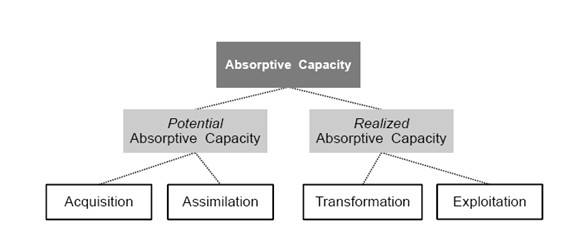Absorptive capacity is an important concept for business owners in many industries. It refers to the ability of an organization to recognize and absorb new knowledge, and apply it in order to strategically improve upon their processes. This understanding can be used both internally and externally by businesses to become more competitive in their respective markets.
The words absorptive capacity are well known to marketing individuals charged with the responsibility of a firm’s innovation process. This concept works in helping firms towards successful innovation and it is one that should be applied to any organization that seeks growth and development in all spheres. But exactly what does it mean and what influence does it have in innovative developments within an organization?
Table of Contents
What is Absorptive Capacity?
Absorptive capacity is a conceptual term characterizing a firm’s ability to recognize value in information arising outside the firm, internalize and assimilate such information, and apply it for commercial purposes. Absorptive capacity is an idea showing an organization’s capacity to secure outside information, understand its value, absorb it, and after that apply the new information for business purposes.
According to research on the concept by Cohen and Levinthal (1990), absorptive capacity as a capability is critical in supporting firms’ innovation capabilities and successful innovation processes within firms. In terms of explaining what determines the extent of a firm’s absorptive capacity, Cohen and Levinthal (1990) argue the capability is driven to a large extent by the firm’s level of related prior knowledge.
Understanding Absorptive Capacity and Innovation Concept
In other words, absorptive limits are a way for firms to find ideas and implement them. This is essential to building its capabilities and competencies regarding innovation. Most of the time, success in this regard highly depends on how a firm collects and adopts new information. The idea of dismissing internal information is not always good. By and large, the information you may be hunting down as of now exists within your organization. And sometimes when you direct outside inquiries you locate that one of the paths of this information leads back into your organization. At the point when this happens, it leaves you baffled on how and why this happens.
The estimation of absorptive limit in this way is when firms have some earlier information they turn out to be more responsive to adding new understandings and thoughts to it. As a person accountable for innovation in your organization, you ought to understand that having an already established learning mechanism that energizes new thoughts and remembering them is at a superior state in improving their innovation processes.
Such organizations often have a better understanding of how and when to integrate and implement the new information into their strategies and concepts. Knowingly, these organizations are advancing learning-which key to innovative developments.
Generating reliable information engages relentless learning, and this has a positive impact as it manufactures the points of confinement and capacities concerning future innovations. Absorptive limit once perceived and developed as a structure propels the output for new discoveries that phenomenally fabricate the ability to make the essential new associations for innovations to take place.
For this to occur, it needs relentless center intrigue. In case firms take the choice course of expecting to smash everything out of the current innovation processes and establishments, organizations after some time make as poor students, they neglect, to expect they have the information and get settled in their attitudes.
They disregard acclimatization, they tend to dismiss and go up against that “not made here” syndrome. That can continue going incidentally before related rot sets in, people leave, and the learning consistently keeps running with them.
As an organization, you have to stop the ‘subjective blinders’ that limit the diversity of opinion by enabling ideas or learning to be all the more comprehensively observed and worked upon and shared all the more transparently. You need to embrace an open innovative spirit in and outside your organization.
It does not quite new learning but rather enables this new information to stream and be assimilated and afterward can be better converted into new and valuable applications.
How Absorptive Capacity Should be Used?
Organizations can use their absorptive capacity when they acquire new knowledge external to the company. This external knowledge acquisition allows them to exploit external knowledge and develop that knowledge, which leads to greater innovation and business performance.
Realized absorptive capacity is essential for a company to be successful in using their own capabilities and resources. Organizations need an organizational absorptive capacity strategy in order to foster knowledge creation and transfer. To do so, companies should identify external sources of knowledge, acquire it in an efficient manner and create the right context for its utilization within their organization.
Organizations can increase their absorptive capacity by engaging in activities such as training programs, research collaborations, open innovation projects and exchanges with other organizations.
For those overseeing innovation inside firms, noteworthy ramifications of the idea are that a more prominent absorptive limit capacity will prompt strong innovation abilities and a higher probability of effectively creating innovations.
In that capacity, people all through a firm should endeavor to create necessary aptitudes and a standard dialect of related information to have the capability to all the more promptly recognize and fathom innovations outside the firm and acclimatize such learning with the point of setting up and seeking after proper business applications.
For those managing innovation within firms, a major implication of the concept is that a greater absorptive capacity capability will lead to strengthened innovation capabilities and a higher likelihood of successfully developing innovations.
As such, individuals throughout a firm should strive to develop essential skills and a shared language of related knowledge to be able to more readily identify and comprehend developments outside the firm and assimilate such knowledge with the aim of establishing and pursuing appropriate commercial applications.
Having a strong internal R&D capability and conducting the firm’s R&D internally can, for example, help to prepare a firm to make better use of external information as part of strengthening the firm’s absorptive capacity.
Cohen and Levinthal’s Model
It can be seen as a tool used to help organizations manage the absorption, assimilation and exploitation of external knowledge. This model suggests that absorptive capacity is first developed through recognizing knowledge in the environment, then it is parsed into acceptable forms for internal use.
Once this process has occurred, an organization can then make use of the newly acquired knowledge to develop new products, solutions and processes. Absorptive capacity, as coined by Cohen and Levinthal, refers to a company’s aptitude to identify the worth of novel information, incorporate it, and effectively utilize it for business purposes.
Zahra and George’s Model
To leverage an organization’s absorptive capacity, Zahra and George proposed a framework which consists of three distinct phases: acquisition, transformation and exploitation.
In the first phase, knowledge is acquired from external sources such as universities, technology providers or customers. To ensure that the newly acquired knowledge is applicable to the organization’s needs, firms must customizethe knowledge to fit their own goals and objectives.
This process is known as the transformation stage, where the external knowledge is adapted to internal needs. Finally, this newly acquired knowledge can be used in innovative ways that will help companies gain a competitive advantage in the market.
Relationship between Absorptive Capacity and Innovation
Organizations with high absorptive capacity can effectivelyutilize external knowledge to enhance their innovative performance. This relationship has been studied extensively and the results point towards a strong positive correlation between absorptive capacity and innovation.
Studies have found that firms with higher absorptive capacity are more likely to introduce new products faster than their competitors, thus allowing them to stay ahead in the market. Furthermore, organizations can reduce their development costs by utilizing external knowledge and leveraging their absorptive capacity.
Innovation Strategies to Enhance Absorptive Capacity
Organizational culture and structures play an important role in improving a firm’s absorptive capacity. In order to increase their internal learning capacity, companies need to develop strong knowledge management systems, which would include activities such as pooling information across departments and divisions. Additionally, firms should focus on developing organizationalstructures and a culture that celebrate creativity, knowledge-sharing and collaboration.
Organizations should also strive to work collaboratively with external partners, both to gain access to external knowledge or expertise and to develop links for facilitating the flow of information back and forth. This can help organizations in leveraging their absorptive capacity by drawing upon the resources of other firms or networks.
Conclusion!
To conclude, organizations that prioritize learning and collaboration, and utilize external knowledge, are primed to enhance their absorptive capacity. This enables them to integrate this external knowledge with their internal knowledge, fostering a fertile ground for technological innovation. It’s clear that absorptive capacity is a vital organ in the body of any thriving, innovative organization.
Liked this post? Check out the complete series on Operations Management


These are great blogs on Marketing91. Thanks for the information. As a marketer, I am alsways trying to learn new and innovative ways to improve results for my clients. Your site is a wealth of great marketing information, concepts, theories and more.